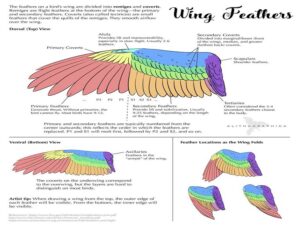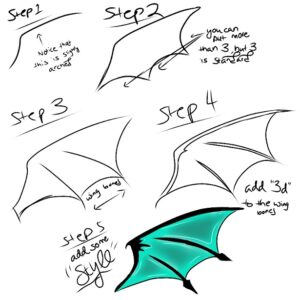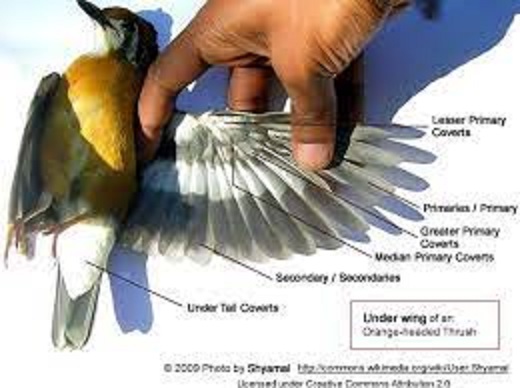Writing about wing anatomy
Writing about wing anatomy we may explain the wing as a structure found in birds that they use to push their body in the air. While anatomy tells the internal structure of any organ. So wing anatomy tells us about the internal structure of the wing.
There are many adaptations of the wings, which may include;
- Swallows have wings that help them to fly at a high speed.
- Vulture has large wings and has a wingspan of six feet that it uses for gliding up the air.
- Penguin uses his wings in swimming, they do not contain feathers.
- Bats also have wings, Flight membrane forms the bat’s wing. This membrane stretches over a thin, long arm and small bones of the hand.
Now writing about wing anatomy we can say that wings are modified forelimb. It contains a hand, as well as shoulder, and forearm. Modifications of hand occurred with time. Reduction of a few bones occurred while others fused. The formation of carpometacarpus occurred with the fusion of the metacarpus bones and a few carpal bones. The fusion of 3 different fingers also occurred. These 3 bones contain alula, from the three frontal bone contains alula. Alula consists of feathers that act as a wing of the plane.
Bird Wings:
Birds can only fly with help of wings by using air currents. Many of the birds own reduced fingers, while they have lengthy forelimbs. These modifications make flight easy and comfortable. So we may say that modification of forelimb results in the formation of wings.
Wings are incomplete without feathers that are essential for flight. While flying push their body in the air with the help of primary flight feathers. These feathers are present on the distal side of the wing. While the top wing is less mobile and contains secondaries. This part aids to raise the bird in the air like robotics animal robotics birds.
Feathers are present in the avian family, and we can identify this family by feathers. In different types of birds, the feathers are also different. The birds also differ from each other due to the color of their feathers. The birds may be identified on the basis of their color of feathers. These wings have joints and with the help of those joints wings have the capacity to bend at three different places. when birds are flying, breast muscles provide the main force for pushing its body in the air.
Bird Wing structure and function:
Writing about wing anatomy bird’s wing shows similarities with mammals. They contain the same bones as mammals, But their bones had modified and merged. Bones of mammals like the humerus (It is a long bone that is the main part of front lambs), ulna (the second most important bone that forms the forearm along with radius), radius, carpal (fused), etc. are also present in the birds. But we may find a difference in the muscular bones because muscles in birds help them to fly.
Bird’s wing shows different structural modifications which are as under:
Bird Wing Feathers

- Birds have feathers, and the anatomy of the feathers is similar to that of hairs in mammals. Feathers are outgrowths of the epidermis as are hairs in mammals.
- Feathers contain keratine and they provide a covering. This covering is light weighted and strong enough to pick the bird up for a flight.
- There are various kinds of feathers like a down feather, contour feather, and flight feather. Flight feather helps the bird in flying and these feathers are also divided into two types that are primaries and secondaries.
Wing Bones
As we are writing about wing anatomy importance of the bones in wings is also important because these bones also take an active part in the flight. These bones give strength for flying, and includes;
The main bone in the wing is the humerus which helps in flight. It is connected with the pectoral girdle (a group of bones that help to connect the main body with the arm). Ulna (the second most important bone that forms the forearm along with radius) and the radius also connects with this bone.
Ulna (the second most important bone that forms the forearm along with radius) and radius are the second most important bones in the wing anatomy. We may note that Radius is larger than ulna in the wings of the birds.
A small facet is present at the distal (opposite from its origin) edge of the radius.
carpometacarpus bones (formed by fused bones) are also present in the wing. It consists of metacarpal II, III, and IV.
Wing’s muscles
Here writing about wing anatomy we will discuss muscles involved in flights. As there are many muscles in the single wing, So it may be hard to explain all in one article. Most birds’ flight depends upon the muscles of the menus part, Brachium, and antibrachium. While we study the wing structure, we come to know that these muscles are used to draw the bones.
Function of Wings in Birds
While we are writing about wing anatomy, this topic will remain incomplete if we don’t talk about the function that the wing performs. As we all know that birds fly with help of wings. So flight is the main function that the wing performs. All the birds have 2 wings, but in some cases, these are not functional for flight. For example, penguins have wings but they use them for swimming. Some mammals also have wings. Bats are mammals that contain wings and can fly easily. There are small wings in some birds that they don’t use for flight. Because these wings are weak, for example, kiwi never fly but it has small wings.
Dragon Wing Anatomy
Dragons have a soft body after birth but its body gets harder while growing. Now as we are writing about wing anatomy we will also discuss the wings of dragons. dragon wings have four supports with the body, whereas birds have only two supports.

Dragon wing is high in weight as it has to lift the heavy body of the dragon in the air. And keep a balance of the body during long flights. These wings have a large wingspan and are larger than the body.
As we talk about the bones of dragon wings, these resemble more to the human hand in anatomy than to bird’s wing. They contain bones like the humerus, phalanx, wrist, and elbow joint.
The dragon scoops the air with help of wings and pushes its body upward for flying. We may compare the flight of a dragon with a baby bird.
published by uxgeneration.com



